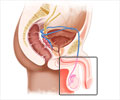Highlights:
- New HIV test has been developed that can detect HIV antibodies in a saliva sample.
- Preliminary evaluation indicates that it is sensitive in detecting HIV positive cases.
- Further evaluation of the test is required before it can be introduced for routine use.
The scientists modified parts of HIV by attaching to one or the other half of a piece of DNA, and added them to the saliva sample. If HIV antibodies were present, they grabbed the modified HIV bits, thus bringing the two halves of the DNA bits together. The whole DNA could then be easily measured through available techniques.
Scientists tested this new approach, called Antibody Detection by Agglutination–PCR (ADAP), in 44 individuals, 22 of whom were HIV positive detected through previous tests, while another 22 were HIV negative. They found that the test:
- Accurately detected the presence of HIV in all the HIV positive individuals.
- Did not produce any false positive results - None of the individuals who were negative for HIV wrongly tested positive by this test.
- Did not detect HIV before blood tests though it is 1,000–10,000 times more analytically sensitive than clinical enzyme-linked immunoassays (EIAs) and may detect the presence of HIV earlier than other saliva tests.
About HIV Testing
The Centers for Disease Control and Prevention (CDC) of the United States recommends testing for HIV at least once in all individuals between the ages of 13 and 64 years. This is particularly important in the following individuals or conditions:- Homosexual males
- Having sex with HIV positive partners, with multiple partners or with someone whose HIV status is not known
- Drug addicts that share injection drugs
- Commercial sex workers
- Diagnosed earlier with a sexually transmitted disease, hepatitis or tuberculosis
- Having sex with a person positive for any of the above
- Pregnant women
Tests commonly used to detect HIV include:
- Nucleic acid tests (NAT): These directly test for the presence of the virus, and sometimes the amount of virus in the sample. They are expensive and therefore not used routinely for screening.
- Antigen/antibody tests: These are the most commonly done tests. A fourth-generation EIA assay that detects both antibodies and the p24 antigen is currently available and is a preferred test.
- Antibody tests: These include the ELISA or enzyme immunoassay (EIA), particle agglutination, and chemiluminescent immunoassay (CIA)
- Tsai C et al. Antibody detection by agglutination–PCR (ADAP) enables early diagnosis of HIV infection by oral fluid analysis. Proceedings of the National Academy of Sciences. Doi: 10.1073/pnas.1711004115
- HIV Basics Testing - (https://www.cdc.gov/hiv/basics/testing.html)
Source-Medindia















